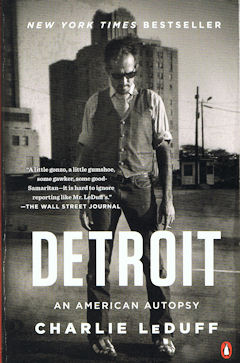





by Charlie LeDuff

Reviewed by Theresa Welsh
|
During the two years Charlie Le Duff spent working as a reporter for the Detroit News, the city was in terrible trouble. It had hit bottom, with its 1950s population of almost 2 million having sunk to under 700,000, leaving its neighborhoods full of abandoned houses; financial insolvency ultimately led to the nation's largest ever municipal bankruptcy. The stories in this compelling book are familiar to me, as I too am a Detroiter. IN THE MIDDLE OF IT ALLLeDuff is a gifted writer and he captures the essence of the Motor City in this surprisingly candid tale of corruption and despair. It is not just the story of Detroit, but also the story of Charlie LeDuff. He is personally involved in the unearthing of a frozen man in an abandoned book warehouse, he details his up-close-and-personal meeting with a seductive Monica Conyers, wife of long-serving Congressman John Conyers, who was on the City Council before landing in jail because she took money from city suppliers. LeDuff breaks bread with fire fighters in decrepit firehouses, commiserating with friends of a fireman killed on the job, and he is with the grandmother of the little girl accidently shot by police as they raided the wrong apartment as crews filmed for a reality TV show. He tells us he later drove her to the cemetery with the ashes of this innocent victim. He is in the middle of everything. I'd be tempted to think LeDuff belongs to the "true if interesting" school of journalism from some of his exploits, but I know from my own experience living and working in the city and researching my own book (I am the author of A Guide to Post-Industrial Detroit: Unconventional Tours of an Urban Landscape) that he has generally provided a true portrait of the city. THE "MOTOR CITY" - THEN AND NOWHe has few good words for General Motors or Chrysler and writes an amusing account of the trip to Washington DC the auto moguls made in private jets to beg for handouts from the federal government during the depths of our recent Great Recession. They were sent back home empty-handed by our Washington legislators, and returned driving their own vehicles, although one exec confided to LeDuff that for the trip home, he used the symbolically correct vehicle only as far as the airport. LeDuff can hold up the auto companies to ridicule since he does not come from a family raised on auto industry money, as I did. My Dad worked in an auto factory for over 40 years before retiring with a nice pension and health care. He was from an immigrant family and started work at age 16 in the foundry at the Buick factory in Flint. He never worked anywhere else, eventually moving to operating a machine that stamped fenders, then getting an easier job as he got old. The UAW got lots of goodies for auto workers in those days, but that is over now. If the auto execs do not command respect any more, neither do the union bosses. My father's story is from an earlier generation, Tom Brocaw's "Greatest Generation," but that was the last generation for whom a job in an auto factory meant lifetime employment and paid retirement. (My father has passed away, but my mother is 95 years old and still getting his GM pension). HIS OWN STORY, REFLECTING HIS CITYCharlie LeDuff's family seems to be as troubled as the city he writes about. Some of the most moving parts of the book are when he writes about his own family, his brothers and their struggles trying to survive in a poor economy and a city whose major industry, like the city itself, fell into bankruptcy. He tells us about his sister, Nicole, who he describes as a "streetwalker," but whom he obviously loves (or "loved" -- she is dead). His sister gave birth to a child at a young age and he tells us about this girl, his niece who wanted to visit him when he moved back to Detroit from New York City. But he never did invite her over and she apparently was too much like her mother; she also is dead. LeDuff writes movingly about his own regrets over these deaths which seem to fit into the fabric of tragedy that plays out every day in the city of Detroit. He weaves the personal stories into the tales of those he meets as a reporter. NO RACE CARD HERELeDuff generally avoids the highly charged subject of race relations in Detroit. The truth is the city has a long, sad history of segregation and poor relations between blacks and whites. I was 22-years old when the 1967 riot got going just a mile or so from the apartment where I was living with my new husband. We lived in one of two all-white apartment buildings in a black neighborhood. We survived a week of constant gunshot fire, National Guard tanks rolling down our street, and the sight, seen from the roof of our building, of fires burning in all directions. But black people did not attack white people, and this riot was about a mostly white police department harassing a mostly black population (take note, people of Ferguson, Missouri). But going back further in time to 1943 when blacks and whites DID attack and kill each other and further back still to 1925 when a black doctor moved into a white neighborhood and fired on a mob about to storm his house and ended up in court, with Clarence Darrow defending him, and you can wonder if all the racial wounds are healed. I think we all know the answer to that. WE'RE ALL MONGRELSLeDuff examines his own ancestry, the LeDuff side, and we find it comes, not from Detroit's own French heritage, but from Louisiana Creole and a Mulatto ancestor who transformed himself from black to white by moving to Detroit. Many light-skinned people of mixed race did this, but once upon a time, you were considered black if you had the tiniest bit of black in you. So Charlie LeDuff: a bit of black, a bit of Native American, and you get ... what? An American! Perhaps the author's own racial confusion has kept him away from putting this most explosive of subjects under consideration. It's a big topic that would require another book. Not that LeDuff remains neutral on the subject of harassment and discrimination and he certainly does not take the side of the white capitalists who tend to run things. He writes of disagreeing with the viewpoint of his bosses at the Detroit News, from which he resigned. (But why did he then go to work for the right-wing Fox TV channel following the publication of this book?) LeDuff points out how the city's impoverishment, caused in part by dishonest politicians who robbed the city coffers, affects people still living there. Firemen without the equipment they need, police with non-working radios, neighborhoods full of trash that's never picked up, street lights that don't work. If you're looking for sad stories, Detroit is full of them. HERE'S WHAT I THINKThe good news is that, since he wrote this book, things are getting better. The bankruptcy (In My Humble Opinion) has been a blessing, with the city shedding billions of dollars in debt while preserving resources needed to improve city services. A new mayor acknowledges and understands the massive problems, a white man elected by a black city for his willingness to fix things. Lots of dangerous buildings have been demolished and many others are being sold to people who have a use for them. The police are responding faster now to emergencies and the city has a police chief so far untouched by scandal. Parts of the city, especially Midtown, look far better than they did when I first came to live in Detroit back in the 1960s. When you hit bottom, there's no place to go but up and Detroit will prove its motto ("We hope for better... it will rise from the ashes") and rise from the ashes of arson, crime and corruption and I believe it is doing that now. Charlie LeDuff's book is an entertaining, funny, and informative read, but it is already out-of-date, a portrait in time of a living city, a time that is passing. Buy Detroit: An American Autopsy Other Books of Interest ~ Read my ebook, A Guide to Post-Industrial Detroit for information on historic sites in Detroit. See book description and check out my ebook about the Packard plant -- description. ~ Check out my Detroit photo essay web pages. |
|
 |
 |